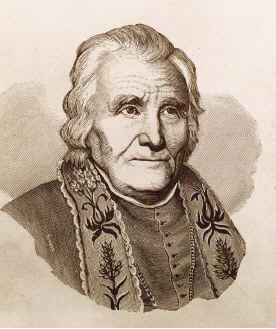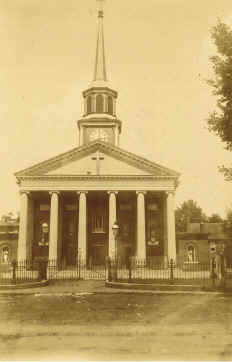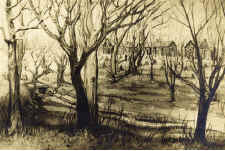My Trip to The Filson
By Michael Pasquier, Filson Fellow
PhD Candidate, Department of Religion
Florida State University
About |
 The Diocese of Bardstown was the
first Roman Catholic diocese founded west
of the Appalachians during the early 19th
century. Bishop Benedict Joseph Flaget and
several other French priests served as missionaries
in the backwoods of Kentucky and
at the crossroads of an expanding Catholic
presence throughout the Old Southwest and
Midwest. They also served as educators and
mentors of the first generation of American
born priests, perhaps the most notable being
Martin John Spalding. The seat of the diocese
moved to Louisville in 1841, but not before
contributing to the imprint of the Catholic
Church in places like Indiana, Missouri,
Louisiana, Texas and Alabama.
The Diocese of Bardstown was the
first Roman Catholic diocese founded west
of the Appalachians during the early 19th
century. Bishop Benedict Joseph Flaget and
several other French priests served as missionaries
in the backwoods of Kentucky and
at the crossroads of an expanding Catholic
presence throughout the Old Southwest and
Midwest. They also served as educators and
mentors of the first generation of American
born priests, perhaps the most notable being
Martin John Spalding. The seat of the diocese
moved to Louisville in 1841, but not before
contributing to the imprint of the Catholic
Church in places like Indiana, Missouri,
Louisiana, Texas and Alabama.
The subject of Kentucky Catholicism is the centerpiece of my doctoral dissertation, “Les Confrères et les Pères: French Missionaries and Transnational Catholicism in the United States, 1789-1865.” These foreign priests thought of themselves as missionaries in a “New World” composed of “heretical” Protestants and “indifferent” Catholics. In the course of their evangelistic endeavor among a surprisingly diverse population on the American frontier, missionaries realized just how difficult it was to practice the priesthood in accordance with what they learned in French seminaries and what they knew Rome expected of them. They recognized how uncomfortable it felt to serve as transnational arbiters of Catholic beliefs and practices between French, Roman and American interests. By understanding the perspectives of French missionaries and by respecting the unsettled religious landscape of the Ohio and Mississippi Valleys, I hope to complicate the popular conception of the American South as a solid Protestant region. I aspire to demonstrate how Catholic missionaries joined Protestant ministers in “Christianizing” frontier peoples, and thus illustrate how Protestants and Catholics shared experiences within a crucible of social change, material poverty, physical hardship and discontinuity with other parts of the new republic.
 Fortunately, for the sake of writing
history, French missionaries developed
close fraternal relationships in Kentucky
which, in turn, led to a refreshingly
open discourse on a range of issues,
including anti-Catholicism, slavery, southern
nationalism and Irish immigration.
Fortunately, for the sake of writing
history, French missionaries developed
close fraternal relationships in Kentucky
which, in turn, led to a refreshingly
open discourse on a range of issues,
including anti-Catholicism, slavery, southern
nationalism and Irish immigration.
The Filson Historical Society holds one of the largest collections pertaining to the history of Catholicism in Kentucky, and it is for this reason I visited The Filson in July and October of 2006. Specifically, I looked to the Diocese of Bardstown, Kentucky correspondence, for insight into the personal experiences of French priests and their collective responses to the evolving social and cultural currents of the early republic. The collection contains over 200 letters and miscellaneous documents written by French missionaries, all of which would have been impossible to ascertain in such an organized and comprehensive context. I also benefited from the expertise of Filson archivists and historians, most notably A. Glenn Crothers, Mike Veach and Jacob Lee.
In addition to conducting research at The Filson, I also had the
privilege to present a paper, “French Missionaries and Borderland
Catholicism in the Upper South,” at the Comparative Perspectives
on North American Borderlands Conference in October of 2006. I
joined the other participating historians in trying to understand the
diversity of life in the American South and West, and I cannot begin
to calculate the impact of our discussions on the ways in which I have
approached the study of Catholicism in Kentucky. Together, we took
seriously what historian Richard White called a “middle ground,”
a space of negotiation and assimilation between disparate peoples.
The backwoods of Kentucky and the wider Ohio River Valley of the
early 19th century, if anything, was a sort of middle ground where
Protestants and Catholics competed for souls and contributed to each
other’s perspectives on life.
calculate the impact of our discussions on the ways in which I have
approached the study of Catholicism in Kentucky. Together, we took
seriously what historian Richard White called a “middle ground,”
a space of negotiation and assimilation between disparate peoples.
The backwoods of Kentucky and the wider Ohio River Valley of the
early 19th century, if anything, was a sort of middle ground where
Protestants and Catholics competed for souls and contributed to each
other’s perspectives on life.
I am indebted to the staff of The Filson Historical Society for their kindness, collegiality and generosity. I am also inclined to thank The Filson for its openness and helpfulness to young historians such as myself. The Filson provides an important service to our understanding of the rich history and culture of Kentucky and the Ohio Valley, and I am a grateful recipient of their support.
![]()
The Filson Historical Society
1310 South Third Street - Louisville, KY 40208
Phone: (502) 635-5083 Fax: (502) 635-5086
Hours
The Ferguson Mansion and Office
Monday - Friday: 9 am. - 5 pm.
Saturday and Sunday closed
Library
Monday - Friday: 9 am. - 5 pm.
Saturday: 9 am. - 12 noon
